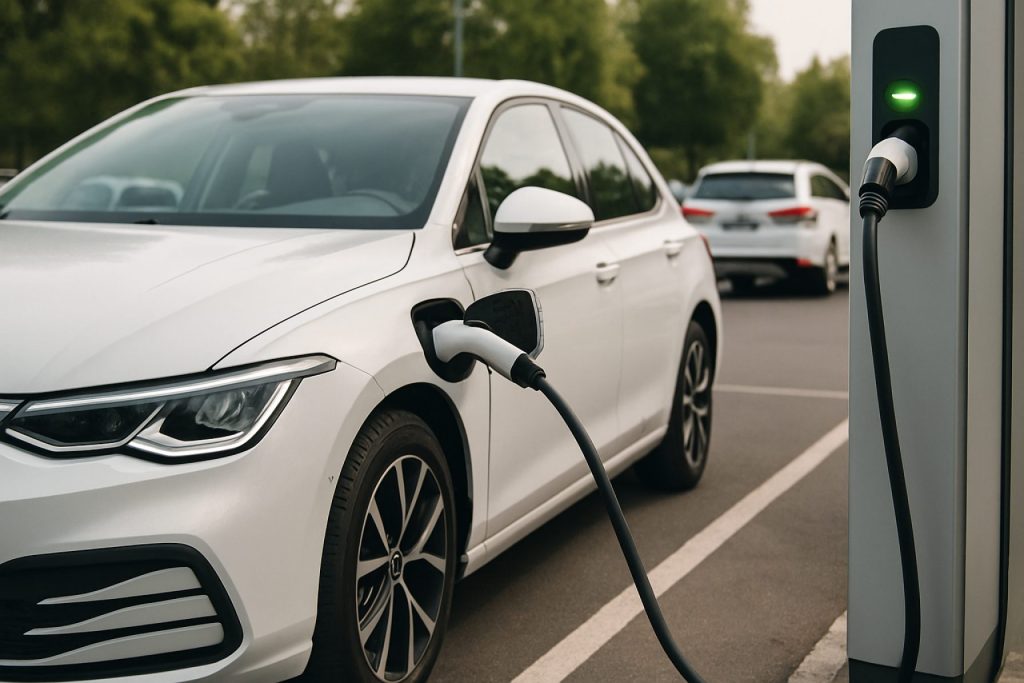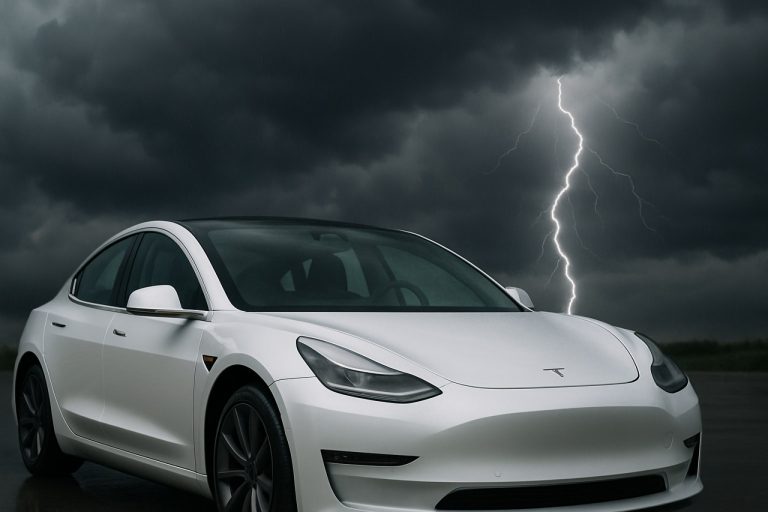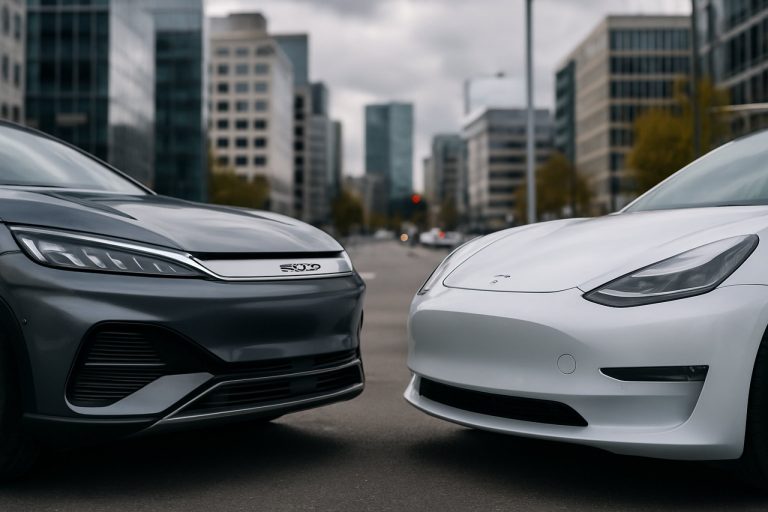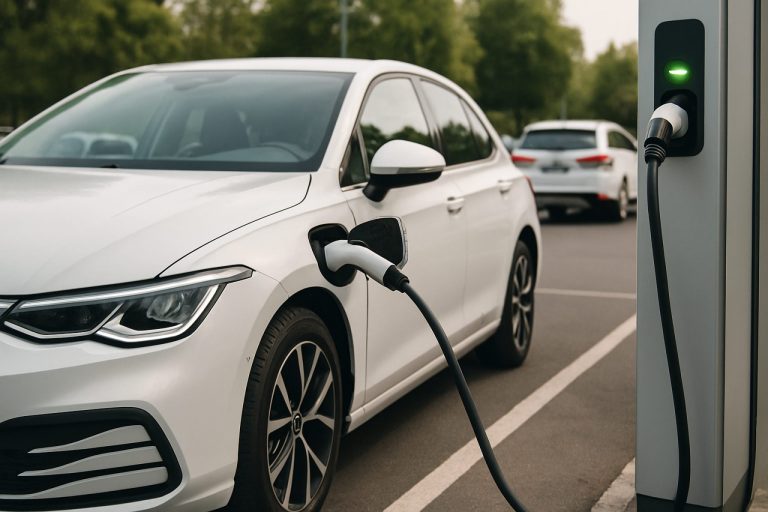
- BYD, a Chinese electric vehicle giant, surpassed Tesla in European EV registrations in April 2024, signaling a major shift in the electric car market.
- BYD’s growth strategy includes competitive pricing, local assembly in Eastern Europe, and leveraging Chinese government subsidies to undercut traditional brands.
- European policymakers express concern over environmental costs, trade imbalances, and accusations of unfair Chinese “dumping.”
- The EU is preparing to impose new tariffs on Chinese EVs, escalating trade tensions and complicating the market landscape for both BYD and local automakers.
- BYD’s surge relies heavily on fleet sales and government-friendly strategies, causing some analysts to question its long-term lead over competitors like Tesla.
- The competition between BYD and Tesla highlights broader geopolitical, economic, and environmental impacts shaping the future of global mobility and trade.
Thunderclouds gather over Europe’s car industry. BYD, a Chinese electric vehicle giant, outpaced Tesla in April’s pure-electric vehicle registrations, sending shockwaves through boardrooms and ministries from Berlin to Brussels. The numbers alone sparkle: BYD registered 7,231 electric vehicles in Europe that month—a 169% year-over-year leap—edging out Tesla by a thin, yet telling, margin. But behind these four-wheeled statistics pulses a convulsion in global trade, politics, and the shape of tomorrow’s roads.
China’s Playbook: Low Prices, Smart Manufacturing, and Geopolitical Judo
How did a brand long overshadowed by American and European icons so suddenly seize Europe’s attention? BYD’s rise does not dwell on a single best-selling model but unfolds through a symphony of strategies. Local assembly plants flourish in Hungary and Eastern Europe, sidestepping Western scrutiny and regulations. These factories, often built with cooperation from local governments eager for Chinese investment, allow BYD to present its vehicles as “European-made.” As a result, the company dodges tariffs while appeasing the region’s hunger for economic reinvigoration.
Another force propels this ascent: price. Underwritten by extensive government subsidies in China, BYD floods showrooms with moderately priced EVs, prioritizing volume over profit. The approach—fiercely competitive, sometimes at the expense of margins—lowers the entry barrier for many buyers, especially as European households eye energy transition incentives and hunt for cheaper electric alternatives to legacy brands.
Yet these attractive prices have a hidden cost. While European consumers enjoy “green” vehicles, the environmental pain of battery production and recycling remains largely contained within China’s borders. This trade-off ignites unease among EU policymakers and environmentalists, forcing a reckoning between affordability and accountability.
Tesla Faces European Headwinds as BYD Accelerates
Tesla, once the imperial banner-holder for EVs, stumbles. Its April sales plummeted by nearly half in Europe, partly because its CEO’s political affiliations find little resonance among European buyers, and partly due to shifting government policies. In the U.S., subsidy regimes now tilt toward reviving traditional automakers, undercutting Tesla’s momentum. Europe, meanwhile, doubles down on “carbon neutrality,” locking in long-term incentives for EV adoption—an environment increasingly favorable for new entrants like BYD.
Trade Tensions and the Shadow of “Dumping”
Behind BYD’s surge, Europe’s unease grows louder. New punitive EU tariffs—set to reach 35%—aim to counteract what many officials see as unfair Chinese subsidies and overcapacity. The stakes? China’s auto industry churns out up to three million EVs annually, twice what the EU can absorb, putting pressure on local carmakers and stirring calls for trade defense.
Negotiations attempt to set minimum price thresholds for Chinese EVs, but no consensus emerges. The question hangs: Will Europe remain an open frontier for low-cost imports, or will political winds reinforce its trade barricades?
The Internal Divide: East vs. West
A more complex fault line cracks across the Continent. Eastern states—Hungary and Serbia most notably—welcome Chinese investments as a shot in the arm for local economies. By contrast, France, Germany, and Italy raise alarms over risks to their hard-fought automotive dominance. This divergence complicates any unified European response, especially as public sentiment and elections shift rightward.
The Numbers Under Scrutiny
Peel back another layer, and BYD’s headline achievement reveals nuance. Much sales volume comes via rental fleets—large purchases by companies like Ayvens—rather than individual buyers. The strategy is clear: achieve presence, visibility, then pivot to the broader consumer market. Plans assemble for new factories in Brazil, Thailand, Turkey, showcasing BYD’s ambition to sidestep tariffs and entrench its influence worldwide.
The Short-Term High of a Global Shakeup
Experts urge caution against crowning a new king too soon. Domestic subsidies, shifting regulations, and spot data points may add up to a temporary lead, not a new order. April’s surge might be a blip, some analysts claim; true change demands consistency and deeper consumer adoption.
Yet, this moment is instructive. BYD’s ascent is more than a business metric; it signals the unspooling of industrial might across continents. The rise commands attention not just from drivers but from lawmakers, strategists, and anyone invested in the world’s clean energy ambitions.
The Road Ahead
As trade barriers rise and global tensions simmer, Europe’s embrace of Chinese EVs could become fraught with risk. Whether BYD and peers turn brief momentum into lasting impact rests on their ability to thrive under scrutiny—and on Europe’s willingness to balance ideals with pragmatism.
Takeaway: The rise of BYD in Europe’s electric car market marks not just a commercial victory, but a flashpoint in the broader story of global industrial power and shifting alliances. Industry watchers and everyday consumers alike will do well to track these developments. What unfolds on European roads today may remake the future of mobility and the rules of global trade for years to come.
China’s BYD Storms Europe: The Real Reasons Behind Its Electric Car Takeover and What This Means for You
The Untold Story Behind BYD’s European Surge
China’s BYD (Build Your Dreams) has made headlines after leapfrogging Tesla to become the top electric vehicle (EV) registrant in Europe for April, driven by savvy pricing, local manufacturing, and a complex geopolitical chess match. But what’s happening beneath the surface? And what should car buyers, investors, and policymakers really be watching? Here’s the deeper dive you won’t find in surface-level headlines, packed with actionable insights.
—
BYD vs. Tesla: Not Just About Sales—What’s Really at Stake?
Features & Specs Comparison:
– BYD: Known for models like the Atto 3, Han, and Dolphin, BYD covers a wide pricing spectrum. Key technologies include the Blade Battery—a lithium-iron-phosphate (LFP) unit with improved safety and lifespan compared to traditional lithium-ion packs. This battery tech is less prone to fire and offers lower degradation.
– Tesla: Tesla dominates with advanced software (Autopilot, Full Self-Driving), robust supercharger networks, and a minimalist design. However, some European buyers see Tesla as less local and more expensive vs. BYD.
Pricing:
BYD frequently undercuts European and American rivals. For example, in Germany, the BYD Atto 3 starts at around €38,000—significantly less than comparable Tesla Model Y configurations.
—
How-To: Buying a Chinese EV in Europe
1. Identify Manufacturer Presence: Check if the manufacturer has local service centers and warranty options.
2. Compare Specs: Analyze battery range, charging speeds, and safety ratings.
3. Assess Incentives: Research regional EV subsidies—BYD’s lower starting prices can often be combined with government grants.
4. Consider Resale Value: As the EV market matures, European-made models (including those assembled in BYD’s Hungary plant) may retain value better.
5. Evaluate Charging Infrastructure: BYD works with pan-European charging networks, but supercharger access lags behind Tesla.
—
Real-World Use Cases
– Fleet Vehicles: Major car rental firms and ride-share companies increasingly order BYD EVs in bulk for sustainability credentials and lower operating costs.
– Urban Households: Affordable pricing makes BYD ideal for city dwellers seeking to switch from combustion cars without breaking the bank.
– First-Time EV Buyers: Lower entry barriers and simple tech onboard cater well to those new to EV motoring.
—
Market Forecasts & Industry Trends
– BYD Expansion: BYD plans new plants in Brazil, Thailand, and Turkey, each designed to avoid tariffs and serve local markets (Source: Financial Times).
– Europe’s Policy Push: The EU Green Deal aims for 55% emissions reductions by 2030. EVs are central, but leaders now weigh stricter import controls—especially as local automakers lose share.
– Chinese EVs in the Lead: According to BloombergNEF, China exported over 1.2 million EVs in 2023, much of it heading for Europe.
—
Security & Sustainability
Security Risks:
– The EU has expressed concern over data security from Chinese-made vehicles, suggesting the potential for future regulatory hurdles (Source: European Commission).
Sustainability Concerns:
– While BYD’s vehicles support Europe’s emissions targets, lifecycle emissions—including battery manufacturing and recycling—raise “outsourced pollution” worries.
– LFP batteries are safer and more recyclable, but not immune from mining controversies.
—
Pros & Cons: An Unbiased Overview
Pros:
– Competitive pricing and strong value.
– High safety with LFP Blade batteries.
– Expansive global supply and adaptability to local regulations.
– Quick market adaptation via local plants.
Cons:
– Overreliance on government subsidies (possible future risk if subsidies fall).
– Question marks over data privacy and cybersecurity.
– Uncertain long-term resale values outside home markets.
– Fast expansion may compromise aftersales service consistency.
—
Pressing Reader Questions & Answers
Q: Will tariffs kill the value proposition of Chinese EVs?
A: The proposed 35% EU tariff would likely lift BYD’s prices, but local production may cushion the impact. BYD is already exploring Hungary as its European hub to label cars “locally made.”
Q: Is there a risk of buy today, gone tomorrow for BYD vehicles/agencies?
A: BYD is one of China’s largest private companies, with $60B+ net worth (Source: Fortune Global 500). Risk is relatively low, but warranty and service network details should be verified before purchase.
Q: Do Chinese EVs meet European safety standards?
A: Most BYD models are Euro NCAP-rated and meet required EU criteria, though some rivals still outperform on driver assistance software.
Q: How do BYD’s batteries compare?
A: The LFP Blade Battery is famous for its “nail penetration test,” showing exceptional fire resistance. But range is sometimes lower than premium Tesla models.
—
Controversies & Limitations
– “Green” Credentials Questioned: BYD’s eco claims are under scrutiny because much of the environmental burden is shifted to battery supply chains in China (Source: IEA).
– Dumping Allegations: The EU argues that China’s direct and indirect subsidies lead to unfair pricing, threatening domestic producers.
– Political Pushback: Governments in Germany, France, and Italy advocate for stricter “anti-dumping” tariffs, while Hungary and Serbia welcome investment for local jobs.
—
Tutorials & Compatibility
– BYD EVs are compatible with most CCS2 charging standards in Europe.
– OTA (over-the-air) updates are available for vehicles with the DiLink infotainment system.
– Mobile apps allow users to monitor charging, vehicle health, and schedule software updates.
—
Actionable Tips for European Buyers & Policymakers
1. Compare Total Cost of Ownership: Factor in up-front cost, incentives, charging costs, and expected depreciation.
2. Inspect Local Assembly: Prefer models assembled in Europe for easier aftersales service and future resale.
3. Monitor Tariff News: Policy changes can alter price and supply rapidly—sign up for EV industry newsletters for updates.
4. Test Drive Chinese vs. Western EVs: Compare build quality, ride comfort, UX, and aftersales promises.
5. Demand Transparency: Push dealerships and brands for battery sourcing and recycling disclosures.
—
Insights & Predictions
– Short-Term: BYD and other Chinese EV makers will keep gaining ground in Europe, especially if tariffs remain patchy.
– Long-Term: Expect a more fragmented European market with local, Chinese, American, and potentially Korean rivals all vying for share. Consolidation and stricter standards are likely.
– Industry Impact: European brands like VW and Renault must accelerate innovation and cost reduction or risk long-term decline.
—
Conclusion—What This Means for You
Industry, policy, and consumer habits are changing fast in the European auto market. BYD’s rise is less a fluke and more a sign of shifting global industries. Whether you’re hunting for your next EV, investing in the sector, or shaping policy, be proactive: monitor tariffs, test all available models, and push for transparency from brands. The electric revolution is global—drive accordingly.
For continued global trade updates, check sources like Reuters and IEA.
—
Keywords: BYD, Tesla, Chinese EVs, European car market, electric vehicles, EU tariffs, BYD Blade Battery, automotive industry trends, car buying tips, data security, sustainability, car market forecasts, trade policy.



